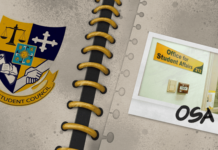“Not what we give but what we share,
For the gift without the giver is bare;
Who gives himself with his alms feeds three—
Himself, his hungering neighbor, and Me.”
-The Vision of Sir Launfal, J. R. Lowell
COMPASSION and commitment are two of the three core Thomasian values, the third being competence. Aside from guiding its students toward excellence in their respective fields of interest, the University also ensures that they live up to the Thomasian ideal of service not only during the Christmas season, but all year round.
Fortunately, not only a few Thomasians respond to this call. To date, the tribe of these service-oriented people increased.
Five out of the 10 outstanding volunteers recently hailed by Hands On Manila, an international organization, are Thomasians. They were commended for their exemplary performance and dedication as volunteers for Acquiring Ready Assistance to Learning (Aral), a project of the Iraya Study Center under the Kalinangan Youth Foundation.
Incidentally, their victory is but an extension of another Thomasian’s brainchild.
About a decade ago, Carlota Pasyon, an alumna of the old UST College of Commerce and Accountancy, co-founded Aral. The initial thrust of the project was to provide the poor children of Algeciras St. with Catechism tutorials. Back then, the sessions were conducted by a small circle of volunteers.
Now, Aral offers tutorials not only in catechism, but also in Math and English. Its corps of volunteers has grown, especially this year, with some 300 Thomasians.
The sudden surge in volunteer numbers is due to the Literacy Training Service (LTS).
Pursuant to Republic Act 9163, otherwise known as the National Service Training Program Act of 2001, LTS, along with the Civic Welfare and Training Service, is offered to enable the students to play a part in social development.
The second semester, unlike the first which is taken on-line through UST’s E-Learning program, is the practical segment. Here, the student teachers get to apply the theoretical knowledge acquired in the first semester.
The task of Aral volunteers is to deal with intermediate students of Tatalon Elementary School: children who are beset by problems in literacy.
Aside from the Iraya Study Center, which accepts only female volunteers and students, the University ties up with different partner communities. The volunteers are given a free hand to sign up for the area of their choice.
Iraya’s male counterpart is the Sarangani Study Center. It was set up by the University Center Foundation, a group of young professionals.
Two programs are being staged by Sarangani at present: the Learn to Read program at the Graciano Lopez Jaena Elementary School on weekdays, and academic tutorials at the Pedro Pelaez Elementary School during Saturdays. Subjects taught are Math, English, and Science.
Three hundred volunteers are likewise deployed to the sites. Sarangani has been coordinating with UST since the LTS course was first offered in the University.
The Basic Ecclesial Communities (BECs) of the Santisimo Rosario Parish have been working with LTS cadets since 2002.
Male and female volunteers conduct the Catechism and Literacy Service where they provide tutorials and spiritual guidance to the children of the six BECs. Partner communities include Algeciras, Prudencio, Marzan-Cristobal, and Paredes-Eloisa streets.
Extra mileage
A different twist was launched this year¯the Distance Education Program, was handled by the Office for Community Development. This year, LTS volunteers joined the program.
The target learners here are adult Aytas in Bamban, Tarlac. The four partner communities are Sitios Mabilog, Malasa, San Martin, and Sta. Rosa.
Volunteers teach basic math, reading, and writing. Out of the seven Sundays allotted for the completion of this semester, three will be spent by the volunteers on site. Thirty volunteers will be sent to each sitio where they will work with the LTS facilitators and para-teachers.
Garry Perez, Sarangani vice director, said, “One of the very important concepts that we’re teaching the students is that they’re free. They do come here because they want to. They want to be trained. They want to share their time.”
The volunteer work has paid off. The partner schools’ reports show that the children who have undergone tutorials have improved their grades.
Not only on the part of the children. Performing charity work can be very rewarding for the volunteers as well.
“There are a lot of compensatory elements that are non-monetary. In this sense, you see your life leading somewhere,” Perez explained.
“The thought that even if only once you have been a volunteer and made a difference with that child, it can have a ripple effect because that child also has his family,” said Mary Anne Bolaños, Aral project coordinator.
Cynthia Diaz, Aral student affairs and academics coordinator, said that the fulfillment derived from volunteer work “is directly proportional to the amount of effort you put into it.”
“It is not just the beneficiary who is helped, but the volunteers themselves should be helped in order for them to realize that there is something they can learn from helping. It’s not only one way; when we help others, we are the ones who are helped most,” she added. Junica P. Soriano










